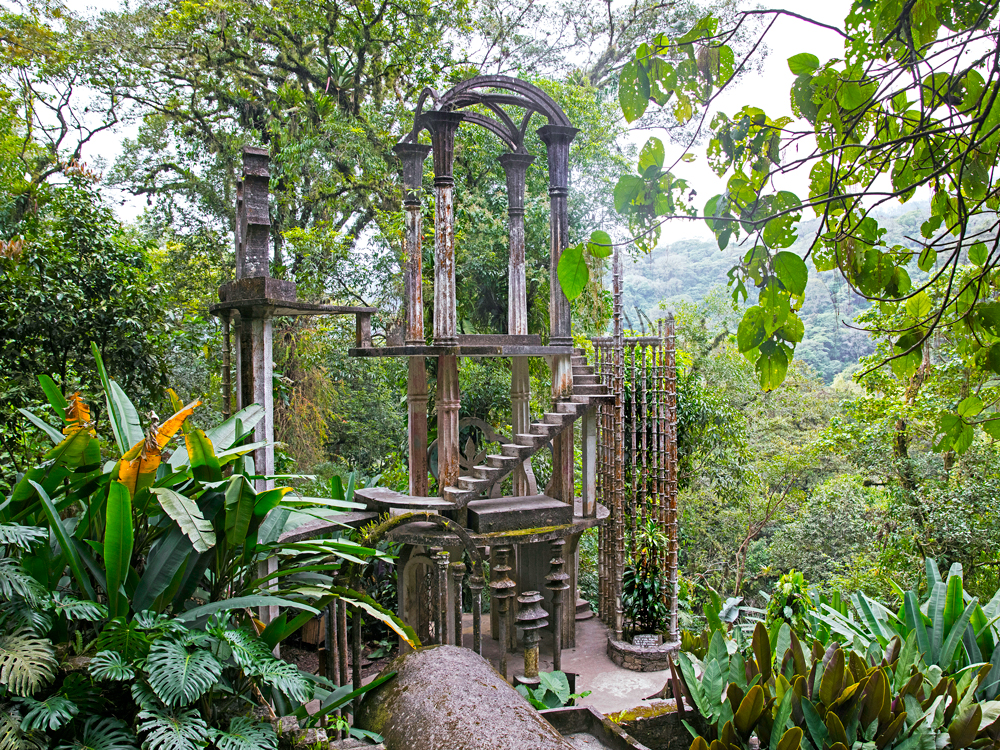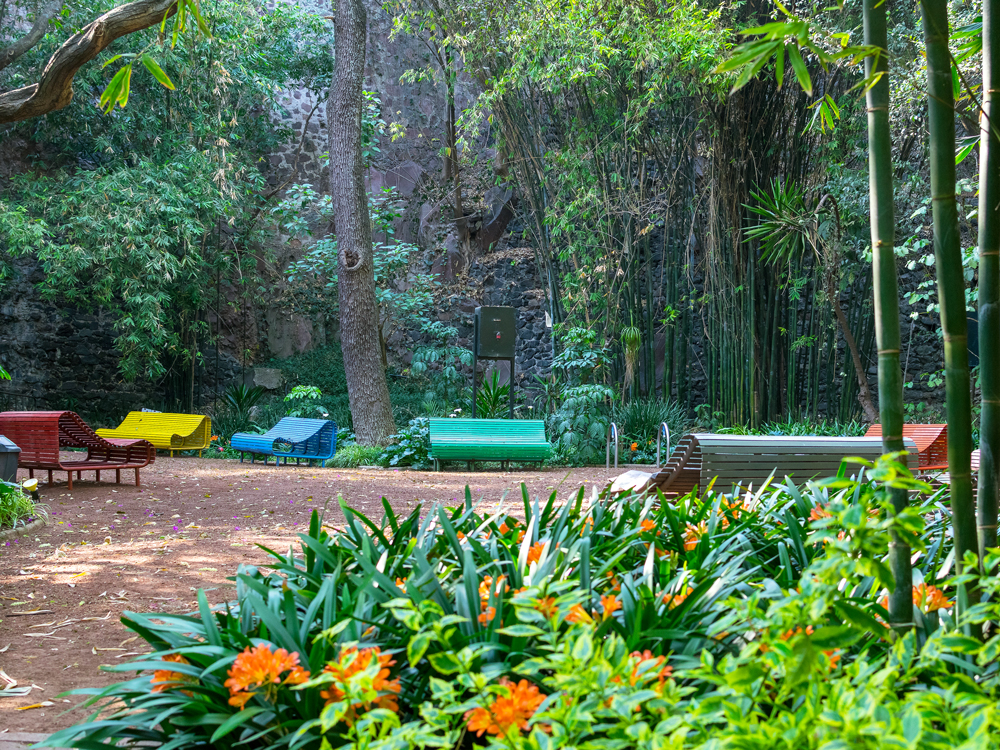Did you know that Mexico’s name really isn’t Mexico? That’s not the only thing you might not expect to find out about America’s southern neighbor. From the largest pyramid in the world by volume (nope, it’s not in Egypt) to a surreal sculpture garden hidden away from the major sights and one of Latin America’s oldest and largest urban parks, here are six fascinating and underrated places to visit in Mexico.
Las Pozas

This stunning sculpture garden is the brainchild of Edward James — an English poet, artist, and patron of surrealist artwork by the likes of Dalí and Magritte. In 1947, James acquired a former coffee plantation in the small town of Xilitla, and he dedicated the 20-acre swath to his collections of orchids and exotic animals. But when an unprecedented cold spell wiped out his plants in 1962, he and his friend Plutarco Gastelum began constructing a sculpture garden that became Las Pozas.
Inspired by orchids and the lush vegetation of the jungle, Las Pozas utilizes fanciful architectural elements borrowed from the surrealist movement. More than 30 sculptures, winding staircases that go nowhere, and cathedral-inspired screens dot the spell-binding property. Streams flow through the grounds, forming nine pools. (The property’s name translates to “the pools” in Spanish.) James often referred to the garden as his “Surrealist Xanadu” — and over decades, he spent millions and employed hundreds in pursuit of his vision. He died in 1984, and today Gastelum’s family manages the property and welcomes visitors from all over the world.
San Miguel de Allende

Nestled in central Mexico’s highlands, San Miguel de Allende was originally an Indigenous Chichimeca village called Itzcuinapan until the arrival of the Spaniards in the 16th century. A Franciscan monk named Juan de San Miguel built a chapel in the village in 1542, and the outpost grew in wealth and power as a market for the silver and tin mined in the region. Today it’s a haven for expats, artists, and tourists drawn to its magnificent and well-preserved colonial architecture — recognized as a UNESCO World Heritage Site — and vibrant cultural and culinary scenes.
The Parroquia de San Miguel Arcángel, a neo-Gothic confection with soaring pink towers that’s often compared to a wedding cake, dominates the city’s historic center. A nearby artisan market is bursting with exquisitely crafted jewelry, brightly painted pottery, and hand-woven textiles. On Saturdays, local cuisine takes center stage at the Tianguis Organico, where sellers offer the region’s bounty of honey, cheeses, chocolates, tamales, and more tasty treats. For a bit of exercise and a spectacular view, take a 15-minute stroll from downtown up to El Mirador, a popular tower with a panoramic overlook of the city.
Chapultepec Park

Chapultepec Park — or Bosque de Chapultepec, as it’s known to locals — is one of Latin America’s oldest and largest urban parks. The park’s history dates back to the Aztecs, whose ruling class utilized the site as a religious center and summer residence. In 1785, construction began on Chapultepec Castle, which sits atop a 200-foot-tall hill and once served as the only North American castle to ever house royalty. It’s now home to Mexico’s National History Museum, one of the park’s highlights.
Chapultepec is divided into four main sections. The first is where you can find many of the park’s museums and a zoo, the second offers a wide array of recreational activities, the third consists of largely untouched forest, and a recent fourth addition in 2021 added to the park’s impressive 1,695-acre expanse. Whether you spend your time here paddling across El Lago de Chapultepec or paying respects at the somber Los Niños Heroes war monument, Chapultepec is a must-visit in Mexico’s sprawling capital.
Cenote Ik Kil

Most visitors to this area of Mexico make a beeline to the great temples of Chichén Itzá (and for good reason), but the dense jungle of the Yucatán peninsula offers another hidden treasure: a magical cenote called Ik Kil. Cenotes are underwater pools that are exposed when the limestone bedrock above collapses, and the Mayans believed the waters of this open-air cavern to be holy — remnants of their sacrifices to the Chaac, the rain god, have been found at the bottom.
Today, Ik Kil (“the place of the winds”) is a refreshing haven for visitors to descend a carved stone staircase into the cenote. Lush vines stretch from the top of the cavern 85 feet down to the 200-foot-wide pond, and swimmers share the space with black catfish that dart through the water that extends a further 150 feet deep. Splash in the cenote’s cool waters as much as you’d like, but be sure to pause and look up at the ethereal surroundings of this once-sacred space.
Great Pyramid of Cholula

It’s the largest pyramid in the world by volume, but the Great Pyramid of Cholula was hidden from view for hundreds of years. When a Spanish army arrived in Cholula, Mexico, in 1519, many of the pyramids built by the Choluteca people were destroyed, but one pyramid managed to escape the Spaniards’ notice.
At the time, the Great Pyramid of Cholula had been abandoned for about a thousand years, and it was so overgrown that it simply looked like a hill. The Spanish built a church on top of that hill, and it wasn’t until 1910 that portions of the pyramids began to be excavated. The pyramid is actually six pyramids nested inside one another, as six different conquering nations added to it. Only three have been explored yet. For comparison, the base of the pyramid is nearly four times larger and twice the volume of the far more famous Great Pyramid of Giza.
Árbol del Tule

The exact age of Mexico’s most famous tree is unknown — it’s estimated to be anywhere between 1,400 and 6,000 years old — but that doesn’t stop residents of Santa María del Tule from throwing it a gigantic birthday party every October, complete with singing, dancing, and fireworks. Located in a churchyard nine miles outside Oaxaca, this stout Montezuma Cypress is certainly worth celebrating. With a 190-foot circumference and branches that span almost the length of two tennis courts, Árbol del Tule (“Tule Tree”) is the widest tree on Earth, according to the Guinness Book of World Records.
Many refer to Árbol del Tule as the “Tree of Life” because it’s possible to observe the shapes of creatures such as lions, jaguars, elephants, crocodiles, deer and fish in its gnarled bark. If you can’t quite make them out, local schoolchildren are happy to help, guiding visitors toward the hidden silhouettes contained within this one-of-a-kind wonder. So wonderful, in fact, that some even believe that the architects of Walt Disney World’s own “Tree of Life” took inspiration from south of the border.
More from our network
Daily Passport is part of Inbox Studio, which publishes content that uplifts, informs, and inspires.
















